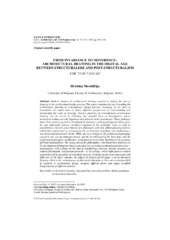Приказ основних података о документу
From invariance to difference: architectural drawing in the digital age between structuralism and post-structuralism
| dc.creator | Meseldžija, Hristina | |
| dc.date.accessioned | 2023-11-27T13:39:38Z | |
| dc.date.available | 2023-11-27T13:39:38Z | |
| dc.date.issued | 2022 | |
| dc.identifier.issn | 0354-4605 | |
| dc.identifier.issn | 2406-0860 | |
| dc.identifier.uri | https://raf.arh.bg.ac.rs/handle/123456789/1676 | |
| dc.description.abstract | Radical changes in architectural thinking resulted in shifting the role of drawing in the architectural design process. This paper examines the act of reading the architectural drawing in contemporary design practice. Focusing on the field of humanities, this paper aims to define different perspectives of understanding and interpreting the work of drawing. Various positions of contemporary architectural drawing can be traced by following two parallel lines of development, whose theoretical settings are still important and relevant in the present-day. These pathways share their common ground in Ferdinand de Saussure’s setting of linguistic theory from the late nineteenth century. Architects engaged in the academic work, as well as practitioners, showed great interest for philosophy and new philosophical practices, which later contributed in re-examining the architectural discipline and establishing a new theoretical framework. In the 1960s, due to a change in the architectural paradigm caused by the current anthropocentrism and the breakthrough of the humanities into the architectural discipline, architecture articulated its own trends, building on the premises of French philosophers. The rising interest for philosophers who based their doctrines on the development of linguistic theory generated two overriding methodological directions – structuralism, with a focus on the idea of establishing universal internal structures as cultural foundations, and poststructuralism - as its critique, which shifts focus to radical articulation of the specificity of individual elements. Considering the terms invariance and difference as the basic concepts, the subject of analysis of this paper is an architectural drawing which in the contemporary architectural education as the most meritorious field of research in architectural design, occupies different forms and enjoys manifold interpretations in different contexts. | sr |
| dc.language.iso | sr | sr |
| dc.language.iso | en | sr |
| dc.publisher | Niš : University of Niš | sr |
| dc.rights | openAccess | sr |
| dc.rights.uri | https://creativecommons.org/licenses/by-nc-nd/4.0/ | |
| dc.source | Facta Universitatis, Series: Architecture and Civil Engineering | sr |
| dc.subject | architectural drawing | sr |
| dc.subject | structuralism | sr |
| dc.subject | post-structuralism | sr |
| dc.subject | digital paradigm | sr |
| dc.subject | architectural education | sr |
| dc.title | From invariance to difference: architectural drawing in the digital age between structuralism and post-structuralism | sr |
| dc.type | article | sr |
| dc.rights.license | BY-NC-ND | sr |
| dcterms.abstract | Меселджија, Христина; | |
| dc.rights.holder | University of Niš, Serbia | sr |
| dc.citation.volume | 20 | |
| dc.citation.issue | 1 | |
| dc.citation.spage | 101 | |
| dc.citation.epage | 114 | |
| dc.identifier.doi | 10.2298/FUACE220515009M | |
| dc.identifier.fulltext | http://raf.arh.bg.ac.rs/bitstream/id/5503/bitstream_5503.pdf | |
| dc.type.version | publishedVersion | sr |

